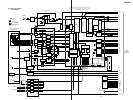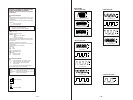
– 28 –
KMS
260A
27X40
B0825
N
Iop = 82.5 mA in this case
Iop (mA) = Digital voltmeter reading (mV)/1 (
Ω
)
7. Then, rotate the – ˜ + knob and display “LDPWR CHECK”.
8. Press the ENTER/YES button once and display “LD 0.9 mW $
”. Check that the reading of the laser power meter become
0.85 to 0.91 mW.
9. Press the ENTER/YES button once more and display “LD 7.0
mW $ ”. Check that the reading the laser power meter and
digital volt meter satisfy the specified value.
Note down the digital voltmeter reading value.
Specified Value :
Laser power meter reading : 7.0 ± 0.1 mW
Digital voltmeter reading : Optical pick-up displayed value ± 10%
(Optical pick-up label)
10. Press the MENU/NO button and display “LDPWR CHECK”
and stop the laser emission.
(The MENU/NO button is effective at all times to stop the
laser emission.)
11. Rotate the – ˜ + knob to display “Iop.Write”.
12. Press the ENTER/YES button. When the display becomes
Ref=@@@.@ (@ is an arbitrary number), press the ENTER/
YES button to display “Measu=@@@.@” (@ is an arbitrary
number).
13. The numbers which can be changed will blink. Input the Iop
value noted down at step 9.
To select the number : Rotate the – ˜ + knob.
To select the digit : Press the CD SYNC/MD WM SYNC but-
ton.
14. When the ENTER/YES button is pressed, “Complete!” will
be displayed momentarily. The value will be recorded in the
non-volatile memory and the display will become “Iop Write”.
Note 1: After step 4, each time the ENTER/YES button is pressed,
the display will be switched between “LD 0.7 mW $ ”,
“LD 6.2 mW $ ”, and “LD Wp $ ”. Nothing
needs to be performed here.
(For details of the method for checking
this value, refer to “5-8. Recording and
Displaying IOP Information”.)
5-11. TRAVERSE ADJUSTMENT
Connection :
Adjusting Procedure :
1. Connect an oscilloscope to CN110 pin 3 (TE) and CN110 pin
1 (VC) of the BD board.
2. Load a disc (any available on the market). (Refer to Note 1.)
3. Press the )/± button and move the optical pick-up out-
side the pit.
4. Rotate the – ˜ + knob and display “EF MO ADJUST”.
5. Press the ENTER/YES button and display “EFB =
MO-R”.
(Laser power READ power/Focus servo ON/tracking servo OFF/
spindle (S) servo ON)
6. Rotate the – ˜ + knob so that the waveform of the oscillo-
scope becomes the specified value.
(When the – ˜ + knob is rotated, the of “EFB= ” changes
and the waveform changes.) In this adjustment, waveform var-
ies at intervals of approx. 2%. Adjust the waveform so that the
specified value is satisfied as much as possible.
(Read power traverse adjustment)
(Traverse Waveform)
7. Press the ENTER/YES button and save the result of adjustment
to the non-volatile memory (“EFB = SAVE” will be displayed
for a moment. Then “EFB = MO-W” will be displayed).
8. Rotate the – ˜ + knob so that the waveform of the oscillo-
scope becomes the specified value.
(When the – ˜ + knob is rotated, the of “EFB- ” changes
and the waveform changes.) In this adjustment, waveform var-
ies at intervals of approx. 2%. Adjust the waveform so that the
specified value is satisfied as much as possible.
(Write power traverse adjustment)
(Traverse Waveform)
9. Press the ENTER/YES button, and save the adjustment results
in the non-volatile memory. (“EFB =
SAVE” will be displayed
for a moment.)
10. “EFB = MO-P”. will be displayed.
The optical pick-up moves to the pit area automatically and servo
is imposed.
V : 0.5 V/div
H : 10 ms/div
Input : DC mod
e
Oscilloscope
BD board
CN110 pin
3
(TE)
CN110 pin
1
(VC)
VC
A
B
Specification A = B
VC
A
B
Specification A = B


















